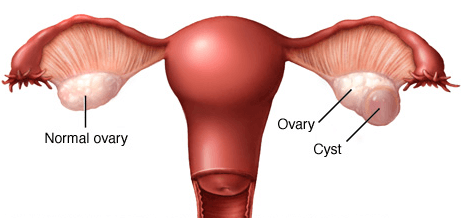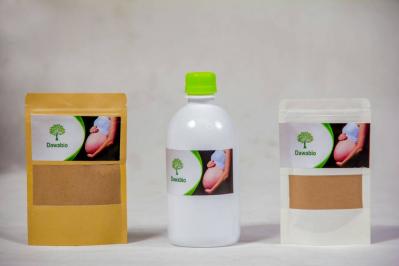Ovarian cysts are sacs or pockets filled with fluid in an ovary or on its surface. Women have two ovaries; Each is the size and shape of an almond and is located on the side of the uterus. The ova (eggs), produced and ripe in the ovaries, are released in monthly cycles during fertile years.
Many women have ovarian cysts at some point. Most ovarian cysts do not present with much discomfort (or very little) and are not harmful. Most go away without treatment within a few months.
However, ovarian cysts (especially those that have ruptured) can cause severe symptoms. To protect your health, perform regular pelvic exams and familiarize yourself with symptoms that may indicate a problem that may be serious.
Dawasante's natural remedy for ovarian cysts
If you have polycystic ovary syndrome and are looking for a natural treatment that will cure you and prevent you from having the operation, this is the natural treatment for you. The herbal tea is made up of several herbs that regulate the hormone levels and the size of your cysts. Indeed, it contains several plants that will mimic the action of estrogen in your body. It is the best natural remedy for curing ovarian cysts. Usually, except when the diagnosis is too late, our natural treatment will cure ovarian cysts without side effects.
To discover our natural treatment for ovarian cysts, click here!!!
To contact our experts please call or write to us on the following number, tel / WhatsApp
: 0022996374527
WE DELIVER ALL OVER THE WORLD
Symptoms that indicate an ovarian cyst
Most cysts don't cause any symptoms and go away on their own. However, a large ovarian cyst can cause:
-Pelvic pain: dull or severe pain in the lower abdomen on the side of the cyst;
-Feeling of fullness or heaviness in the abdomen;
-Swelling
The causes of ovarian cysts
Corpus luteum cyst
Most ovarian cysts occur after the menstrual cycle (functional cysts). Other types of cysts are much less common.
Functional cysts
Structures similar to cysts, called "follicles," usually develop every month. The follicles produce the hormones estrogen and progesterone and release an egg when you ovulate.
If a normal follicle continues to grow, it is called a “functional cyst”. There are two types of functional cysts:
· Follicular cyst Approximately in the middle of the menstrual cycle, an egg leaves its follicle and passes through the fallopian tube. A follicular cyst begins when the follicle does not break or release the egg, but continues to grow.
- Corpus luteum cyst. When a follicle releases the egg, it begins to produce estrogen and progesterone for conception. The follicle is now called the "corpus luteum". Sometimes fluid collects inside the follicle, which causes the corpus luteum to expand and a cyst to form.
Functional cysts are usually harmless, rarely cause pain, and usually go away on their own within two or three menstrual cycles.
Other cysts
Types of cysts that are not related to the normal functioning of the menstrual cycle are:
· Cyst dermoid. These cysts, also called "teratomas", can contain tissue, such as hair, skin or teeth, because they are formed from embryonic cells. They are usually not cancerous.
· Cystadenomas These form on the surface of an ovary and may be filled with a watery or mucous material.
· Endometriomas They are formed as a result of a disease in which uterine endometrial cells develop outside the uterus (endometriosis). Some tissue can adhere to the ovary and form a lump.
Dermoid cysts and cystadenomas may be enlarged, which can cause the ovary to move out of its position. This increases the possibility of a painful torsion of the ovary, called "ovarian torsion". Ovarian torsion can also cause blood flow to the ovary to decrease or stop. In fact, ovulation is the release of an egg from one of the ovaries. It usually occurs in the middle of the menstrual cycle, although the exact time may vary.
In preparation for ovulation, the uterine lining, or endometrium, thickens. The pituitary gland in the brain stimulates one of the ovaries to release an egg. The wall of the ovarian follicle breaks on the surface of the ovary. The egg is released.
Elongated structures called "fimbriae" carry the egg to the nearby fallopian tube. The egg travels through the fallopian tube, driven in part by contractions of the walls of the tube. Once in the fallopian tube, the egg can be fertilized by a sperm.
If the egg is fertilized, the egg and sperm join together and form a single-celled entity called a zygote. When the zygote moves down the fallopian tube into the uterus, it begins to divide rapidly and forms a group of cells called blastocysts, which looks like a small raspberry. When the zygote reaches the uterus, it is implanted in the uterine lining and pregnancy begins.
If the egg is not fertilized, the body simply reabsorbs it, perhaps even before reaching the uterus. About two weeks later, the lining of the uterus breaks off and is expelled through the vagina. This is called menstruation.
Risk factors
The risk of having an ovarian cyst increases due to:
· Hormonal problems: These include taking clomiphene (Clomid), a fertility medicine used to stimulate ovulation.
· Pregnancy: Sometimes the cyst that forms when you ovulate stays in the ovary throughout the pregnancy.
· Endometriosis: This condition causes uterine endometrial cells to grow outside the uterus. Some tissue can adhere to the ovary and form a lump.
· A severe pelvic infection: If the infection spreads to the ovaries, it can cause cysts to form.
· A previous ovarian cyst: If you have a cyst, you probably have more.
I have cysts and I'm pregnant… Is it time to panic?
Ovarian cysts are common in early pregnancy, even if you are not having your period. Usually, these cysts are harmless, just like most other ovarian cysts.
· However, if the cysts continue to grow throughout your pregnancy, there are a few possible problems. They can break, twist, or even cause problems during childbirth. This is one of the many reasons why it is important to stay under the care of an obstetrician/gynecologist during your pregnancy and throughout your life.
- If you have polycystic ovary syndrome you are at increased risk for gestational diabetes, pregnancy-induced high blood pressure, miscarriage or premature delivery.
· Talk to your OB / GYN about your risks and potential treatment options. She will provide you with a full set of options and recommend the best treatment to help you have the healthiest pregnancy possible.
Ovarian cysts: what consequences before pregnancy?
- Most of the time, having one or even more ovarian cysts does not prevent you from getting pregnant. Functional cysts do not really interfere with fertility (many women get pregnant naturally without even suspecting their presence) or only temporarily, while they resolve. For example, a follicular cyst can prevent ovulation during one cycle, but may not interfere with ovulation in the next cycle. In addition, if these cysts are slow to leave, hormonal treatment can accelerate their disappearance and return to a normal menstrual cycle with good ovulation.
- As for endometriosis and polycystic ovary syndrome, they can have a very small or greater impact on fertility depending on the severity of the disease: if necessary, treatment can be implemented to facilitate pregnancy. In general, large endometrial cysts are removed surgically while hormonal stimulation often helps to ovulate normally in polycystic ovary syndrome. Many women thus manage to become pregnant and carry on their pregnancy after these treatments.
Ovarian cysts: what consequences during pregnancy?
- It happens that an ovarian cyst is discovered accidentally, during a mandatory ultrasound during pregnancy. A small asymptomatic cyst often only requires simple monitoring, to make sure that it does not grow too large: normally, it will not interfere with the development of your future baby, or even your delivery.
- In the end, it is especially the cysts causing severe pain that must be removed surgically. The same can be said for very large ovarian cysts, which are often removed as a preventive measure (without treatment, a large cyst could trigger ovarian torsion). If this type of cyst is discovered during the very first months of your pregnancy, the operation will normally be postponed until the beginning of the second trimester: at this stage, it will no longer present any particular risks for your baby. In the meantime, the doctor may give you a rest.
To contact our experts please call or write to us on the following number, tel / WhatsApp
: 0022996374527


